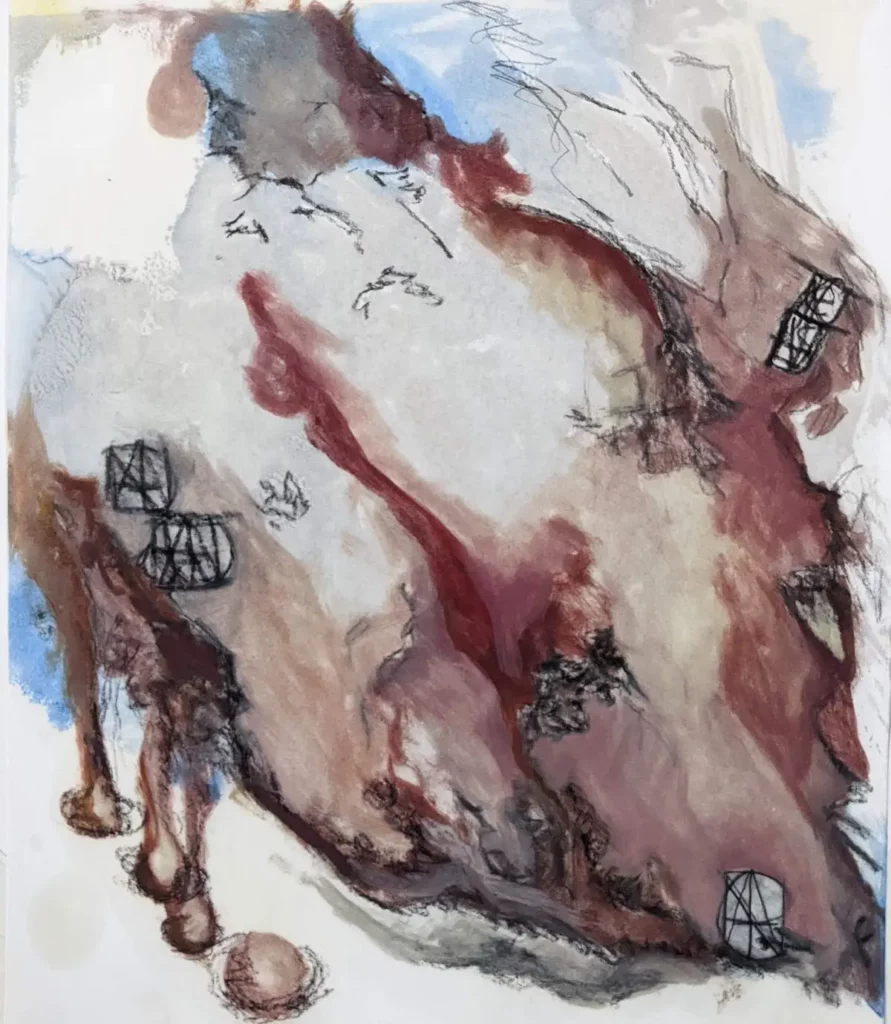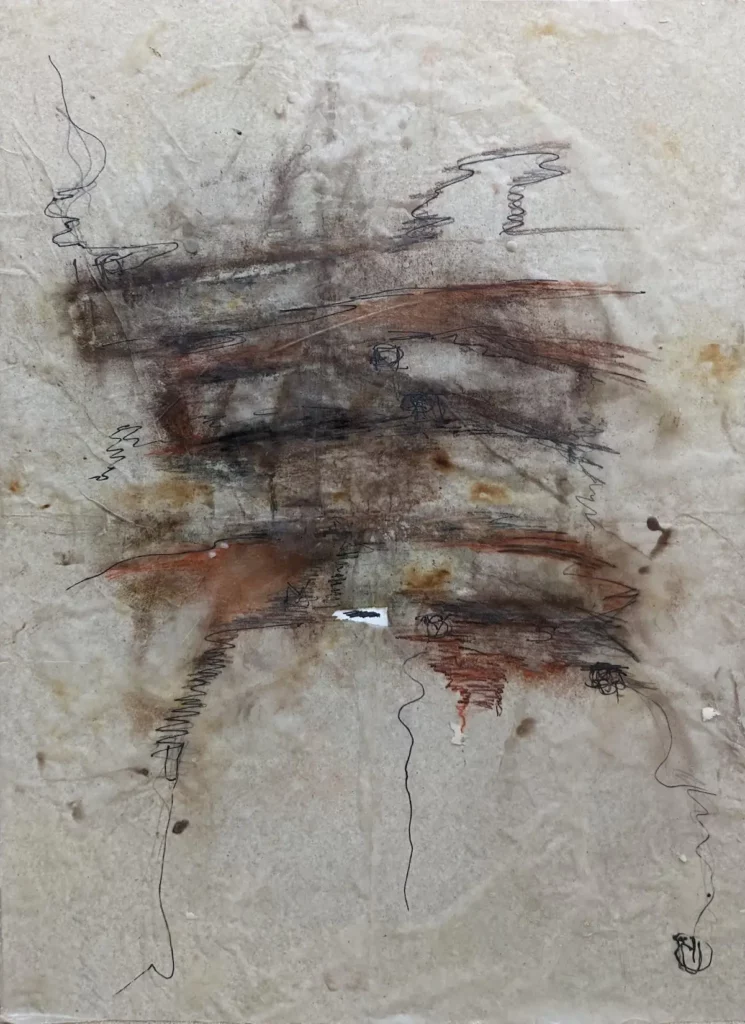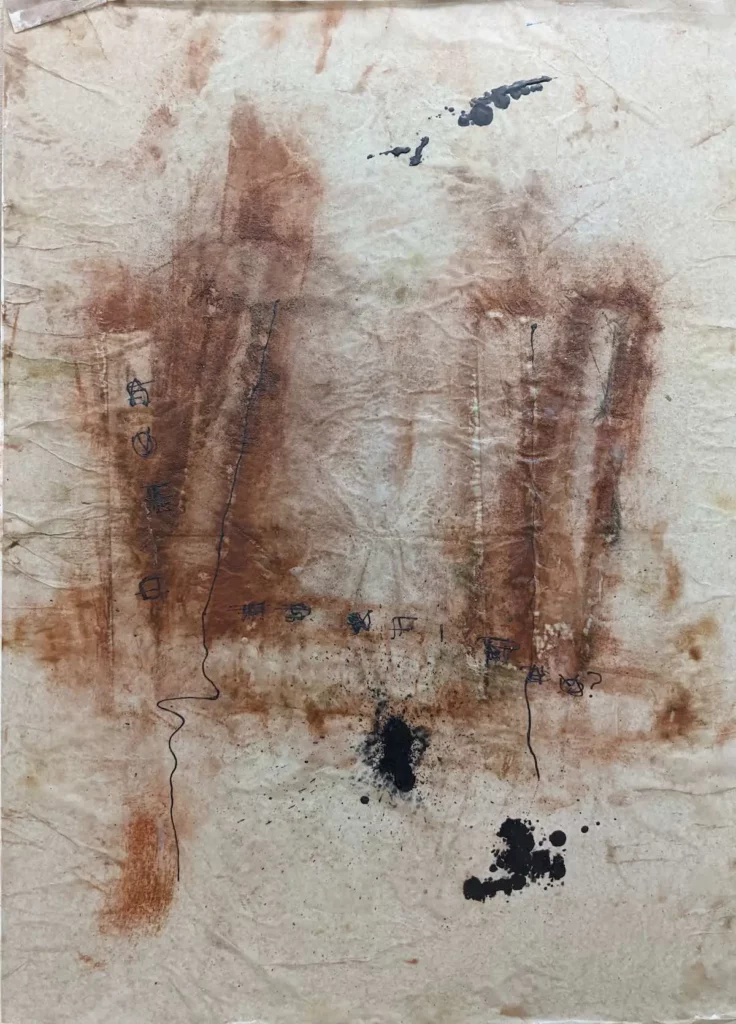As a high school art teacher, Lindsay Metcalf fosters growth and change in her students. As a mixed media artist, Lindsay embodies those principles in her own work while modeling an artistic practice for the next generation of artists. Exploring new methods and materials stretches her as an artist and helps her build fresh work that builds on a solid foundation.

How did you find yourself on an artist’s path? Always there? Lightbulb moment? Dragged kicking and screaming? Evolving?
I have always been drawing or coloring since I was a little kid. I had a tendency to alter many of my toys. Often, I cut up storybooks or cut Barbies’ hair or otherwise altered the things I owned.
My grandmother was a painter and was a Certified Decorative Artist through the Society of Decorative Painters. She always maintained a workspace in her home to create her artwork. Cracker Barrel commissioned her to create a decorative plate, and she did ornaments for the White House Christmas tree. I took a lot of inspiration from her and the time that she carved out for her work, and I contribute a lot of my schooling success to her.
I was definitely an art kid in high school, and majored in art through college, eventually earning my MFA. I’ve been in the art world in some capacity pretty much my whole life.
As an Amazon Associate I earn from qualifying purchases. Read more about our affiliate linking policy.

Are there recurring themes in your work? What is it about a subject that inspires you to continue exploring it?
I definitely explore the figure, bodies, and language in my work very consistently.
In my undergraduate studies, I did a lot of figure drawing and at one point thought I wanted to pursue medical illustration as a career path. That took me into some anatomy and physiology studies. I think the human form, whether presented representationally or in abstraction, is endlessly fascinating. It is interesting that we often talk about ourselves separately from our bodies, as if we move through the world as two synced up entities. I like to break down the parts of that.
The presence of abstracted language in my work is a relatively new development, but one that I hope to continue exploring. As a neurodivergent woman, I have become more and more aware as I get older and learn more about myself, that I have a particular relationship to the written word. I have been exploring that through my work in recent years.

How does your chosen medium help you express those concepts?
I oscillate between printmaking which can be very tight and process based to more abstracted painting approaches. The juxtaposition of these methods I think mirrors the natural juxtaposition that is present in my work: the representation vs abstraction of bodies, the exploration of process, the deconstruction of language. All of these themes call for the presence of both methods of working.
What do you do differently? What is your signature that makes your work stand out as yours?
I will be honest, I had to answer this question last! One of the key features of being an artist is you constantly struggle with imposter syndrome, I think. There are so many fantastic voices out there, and as an arts educator I am constantly humbled. I think what makes me stand out is the physicality with which I approach my mark making, and the way that I manipulate written language.

Is collaboration always part of your process? What are the joys and challenges? When you work solo, does the collaboration model apply – are you collaborating with yourself?
Collaboration has made up a small part of my art making on the whole. For me, art making becomes a sacred ritual carried out in private, often as a means of decompression or processing. When I do collaborate, it’s with the shared understanding that there is something specific we are processing. Collaborating with my brother, we set the intention of processing our relationship – how we navigate the world separately and together. Since we had a shared intentionality, the process of collaborating was extremely rewarding.
When it comes to creating, are you more of a planner or an improviser?
I’m an improviser who fancies herself as a planner. I would love to be able to plan a body of work, and I spend a lot of time ruminating. However, when it comes to creating, I’m definitely an improviser.

Do you have a dedicated space for creating? If so, what does it look like?
Since I teach high school art, I utilize my classroom as my studio. I have a small shelf where I keep my personal supplies and store my work on the drying racks with my students. Especially with my upper-level students, I like to work alongside them whenever it is appropriate. I will stay after school when I am able to focus on my own work.

How does your studio organization contribute to your work process?
Since I share a workspace with my students, organization becomes paramount. Everything needs to be in its place for both me and my students. Since my students require organization and all objects have a home, that is part of my working process.

What are the indispensable tools and materials in your studio? How do they improve your work?
I’m never without charcoal pencils. It feels a little basic, but they check so many boxes for me! I can work tight or loose, I can work with them dry or add water, and they come in wonderful earthy hues. The accessibility and portability of them keeps me working.

What is your favorite lesser-known tool for your trade? Have you taken something designed for another use and repurposed it for your studio?
I don’t know if this counts as lesser known anymore, because I think it’s had a sort of renaissance recently, but I love working with encaustic. It has forced me to work in ways I might not have before, and is something I feel that I am still mastering. As far as repurposing, I know it isn’t the most original, but I love to work with cardboard or plywood as my matrix.

Do you use a sketchbook or journal? How does that help your work develop?
My sketchbook takes a few forms. I use a traditional sketchbook, drawing apps on an ipad, and the notepad on my phone. I try to capture ideas or impulses in the moment, and that way when I can sit and focus with my work, I have those authentic thoughts recorded and at my fingertips.
What plays in the background while you work? Silence? Music, audiobooks, podcasts, movies? If so, what kind?
Music, for sure. I’m a metal-head at heart, so usually that, but sometimes just something atmospheric.

How has your creativity evolved over the years? What triggered the evolution to new media/kinds of work/ways of working?
When I was younger, my creativity centered on representational work, which led into the medical illustration drawing that I mentioned before. When I focused around that type of imagery, I think it was actually easier intellectually (for me) to sit down and make things. It felt like the stakes were lower. As I get older my work has definitely moved into the more expressionist vein. I think the shift comes from a need to approach something new. I think I did the same thing for so long and I felt like I needed a change.

Do you think that creativity comes naturally to people, or do you think creativity is a skill that people can learn?
It definitely comes naturally. There’s science behind how children make marks and how there are connections and commonalities regardless of borders. Also, we all know drawing/mark making is one of the first things children do! I think creativity is a skill we need to maintain, not learn.

How do you deal with creativity blocks?
I take breaks. I also enjoy weightlifting and fitness, and when those muscles are sore, you rest them. So, I treat my creativity the same way. Sometimes it is a complete break, and sometimes it’s reading about creative folks instead of being creative myself. I think it’s overall important to not beat yourself up when you aren’t firing on all cylinders.

What was the biggest challenge that you encountered on your creative journey? What did you learn from it?
For me it was a challenge when I was younger to not treat the success of other artists as an indication of my own failure. When I was young, it was definitely about recognition, compliments, etc. It used to bother me a lot that outside of academia I have not had a solo exhibition up to this point. I’m definitely at peace with that now and understand that my creative practice is primarily for me. The rest will follow.

If you could interview a creative person (past or present), who would that person be? What is it about that person that intrigues you?
Joni Mitchell! I would love to speak to her directly about her process and see how she gets so much energy in her work. I’m also in awe of how she was able to find so much success in a male dominated world in the mid 20th century.
Tell us about your blog website. What do you hope people will gain by visiting?
At this point, it’s mainly a way for me to get my work out there. Despite having an education in the arts, attending conferences, etc., etc., networking has always been my Achilles heel. Right now, it’s my little slice of presence in the world that becomes a way for my work to speak for itself. Hopefully, as I continue to grow into my practice, it will develop into more than that.
Learn more about Lindsay Metcalf.
Interview posted October 2022.
Browse through more inspiring interviews with makers on Create Whimsy.

